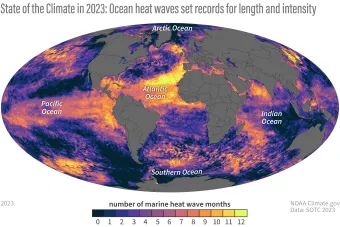
- NOC scientists contribute to 34th annual State of the Climate report
- Record sea surface and marine air temperatures experienced in 2023
- 94% of the global ocean surface experiencing at least one heatwave event in 2023
Greenhouse gas concentrations, the global temperature across land and ocean, the global sea level and ocean heat content all reached record highs in 2023, according to the 34th annual State of the Climate report.
The international annual review of the world’s climate, led by scientists from the US National Oceanic and Atmospheric Administration’s National Centers for Environmental Information, with key contributions from National Oceanography Centre (NOC) scientists, has been published by the Bulletin of the American Meteorological Society (AMS).
The report, written by over 500 scientists from over 60 countries and subjected to a thorough peer-review process, provides the most comprehensive update on Earth’s climate indicators.
NOC scientists contributed their deep expertise on the Atlantic Meridional Overturning Circulation (AMOC), a major system of ocean currents and eddies that form a loop spanning the length of the Atlantic.
They also contributed sections focusing on sea surface/marine air temperatures and sea level variability.
Record sea surface temperatures
Dr Richard Cornes, a senior research scientist in NOC’s Marine Physics and Ocean Climate group, led the Night Marine Air Temperature section of the Global Climate chapter. He highlights the record sea surface and marine air temperatures that were experienced in 2023.
“Following the El Nino conditions that developed in the latter half of the year, exceptionally high temperature anomalies were experienced globally. Particularly extreme anomalies were also recorded in the Northern Hemisphere,” he says
“The frequency of marine heatwaves was also high, with 94% of the global ocean surface experiencing at least one heatwave event and around half of those being strong and 10% severe.”
Rising sea levels
Dr Svetlana Jevrejeva, a sea level scientist in NOC’s Marine Systems Modelling group in Liverpool, contributed to the Sea level variability and change section of the Global Oceans chapter.
She highlights the annual average global mean sea level (GMSL), gathered from satellite altimetry (1993–present), which reached a new high in 2023. It rose to 101.4mm above levels in 1993, due to increased contribution of ice melt from ice sheets in Greenland and the Antarctic, glaciers and thermal expansion of the ocean.
This marks the 12th consecutive year that GMSL saw a year-on-year increase, continuing a trend of around 3.2mm a year (with 0.4mm variability) since 1993, compared to 1.6 mm during the 20th century, indicating an acceleration in sea level rise.
Continued monitoring is essential
“The temperatures experienced across the global ocean in 2023 represent a notable increase above previous warm years,” says Dr Cornes. “An important feature of this report is the bringing together of evidence from a wide variety of datasets”.
“It is likely that the global average temperature threshold of 1.5°C above pre-industrial levels specified in the Paris Agreement will be temporarily met or exceeded in the next few years. The continued monitoring of global ocean temperature via high-quality datasets will remain essential for quantifying threshold exceedance and for determining the efficacy of mitigation efforts”.
Other notable findings from the State of the Climate in 2023 report
In 2023, greenhouse gas concentrations were the highest on record, with the fourth highest year-on-year growth since the 1960s.
Global mean sea level was a record high for the 12th consecutive year, reaching about 101.4mm above the 1993 average, when satellite altimetry measurements began. It was also making it the third highest year-over-year increase on record.
On 21 February, Antarctic sea ice extent and sea ice area both reached all-time record lows, surpassing the previous record lows that were set just a year earlier in February 2022. On 6 July, a new record-low daily sea ice extent was 695,000 square miles (1.8 million square kilometres) lower than the previous record low for that day.
The State of the Climate report is a peer-reviewed series published annually as a special supplement to the Bulletin of the American Meteorological Society.
Read more on this Report
The full report is openly available online. NCEI’s high-level overview report is also available.
Image: The map shows the number of months each part of the global ocean experienced heat wave conditions in 2023, meaning that for a given time of year, the monthly average temperatures were in the hottest 10% of all monthly temperatures from 1991–2020. Very few areas experienced less than one full month of heat wave conditions (darkest blue). Relatively large swaths of the eastern North Atlantic experienced heat wave conditions virtually all year (bright yellow). NOAA Climate.gov image, adapted from Figure SB3.1 in State of the Climate in 2023.
About NOC
NOC is the UK’s leading institution for integrated coastal and deep ocean research. NOC undertakes and facilitates world-class agenda-setting scientific research and technology development to understand the global ocean by solving challenging multidisciplinary, large scale, long-term marine science problems to underpin international and UK public policy, business and societal outcomes. NOC is a company limited by guarantee set up under the law of England and Wales (11444362) and registered as a charity (1185265).
NOC operates the Royal Research Ships James Cook and Discovery and develops technology for coastal and deep ocean research. Working with its partners NOC provides long-term marine science capability including: sustained ocean observations, mapping and surveying; data management and scientific research and advice.
Among the resources that NOC provides on behalf of the UK are the British Oceanographic Data Centre (BODC), the Marine Autonomous and Robotic Systems (MARS) facility, the National Marine Equipment Pool (NMEP), the National Tide and Sea Level Facility (NTSLF), the Permanent Service for Mean Sea Level (PSMSL) and British Ocean Sediment Core Research Facility (BOSCORF).